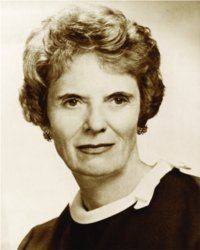Name Mina Rees Role Mathematician | ||
 | ||
Died October 25, 1997, New York City, New York, United States People also search for Marimi Matsushita, Arthur W. Radford, Edward A. Craig | ||
The story of john rothman volunteer archivist for the gc s mina rees library
Mina Spiegel Rees (August 2, 1902, Cleveland, Ohio – October 25, 1997, New York City) was an American mathematician. She was the first female President of the American Association for the Advancement of Science (1971) and head of the mathematics department of the Office of Naval Research of the United States. Rees was a pioneer in the history of computing and helped establish funding streams and institutional infrastructure for research. Rees was also the founding president and president emerita of the Graduate School and University Center at CUNY. She received the Public Welfare Medal, the highest honor of the National Academy of Sciences; the King's Medal for Service in the Cause of Freedom (UK) and at least 18 honorary doctorates.
Contents
- The story of john rothman volunteer archivist for the gc s mina rees library
- Personal life
- Education
- Career
- Honors
- Notable publications
- References
Personal life
Rees was the daughter of Moses and Alice Louise (née Stackhouse) Rees. The family moved from Cleveland, Ohio to New York where Rees received her primary education in the city's public schools. In 1955, Rees married physician Leopold Brahdy. She died in 1997 at the Mary Manning Walsh home in Manhattan.
Education
She was valedictorian at Hunter College High School in New York City. She graduated Summa cum Laude with a math major at Hunter College in 1923. She received a masters in mathematics from Columbia University in 1925, where she also studied law. At that time she was told unofficially that "the Columbia mathematics department was not really interested in having women candidates for Ph.D's". She started teaching at Hunter College then took a sabbatical to study for the doctorate at the University of Chicago in 1929. She earned her doctorate in 1931 with a dissertation on abstract algebra titled "Division algebras associated with an equation whose group has four generators," published in the American Journal of Mathematics, Vol 54 (Jan. 1932), 51-65. Her advisor was Leonard Dickson.
Career
During her time at the Office of Naval Research, Rees headed research in a variety of programs, including hydrofoils, logistics, computers, and numerical development for applications such as rocketry and defense against submarines. She was especially instrumental in developing the ONR's implementation of projects studying mathematical algorithms for computing, as well as university research programs to build computers such as Project Whirlwind at MIT. She was an early proponent of magnetic-core and electrostatic memory, the use of transistor components rather than vacuum tubes, and the design of machines with visual displays and multiple inputs.
The New York Times wrote "Dr. Rees also had an important role in the growth and diversification of mathematical studies. Many of her ideas left their mark on fast computer technology.
"Dr. Rees enjoyed a crowning moment in 1969, when the 120,000-member American Association for the Advancement of Science elected her president. Women remained something of a rarity at that level in the scientific community, but she -- as Marie Curie, Lisa Meitner and Dr. Margaret Mead before her -- had proved that scientific creativity was not just for men."
Honors
In 1953, the council of the American Mathematical Society adopted a resolution reading stating that under Dr. Rees' "guidance, basic research in general, and especially in mathematics, received the most intelligent and wholehearted support. No greater wisdom and foresight could have been displayed and the whole postwar development of mathematical research in the United States owes an immeasurable debt to the pioneer work of the Office of Naval Research and to the alert, vigorous and farsighted policy conducted by Miss [sic] Rees."
In 1962 Rees received the first Award for Distinguished Service to Mathematics from the Mathematical Association of America. This award was made "for outstanding service to mathematics" and for "contributions [that] influence significantly the field of mathematics or mathematical education on a national scale."
In 1965, Rees was awarded the Achievement Award by the American Association of University Women, an award given annually in honor of women who have made outstanding contributions in their fields.
The Public Welfare Medal, the highest honor of the National Academy of Sciences, 1983, "in recognition of distinguished contributions in the application of science to the public welfare....for her contributions to the scientific enterprise, especially in mathematics, astronomy, and computer sciences, from wartime, through the transition from war to peace, and continuing today."
Kings Medal for Service in the Cause of Freedom (UK) and the President's Certificate of Merit (USA) for her important contributions during World War II.
At least 18 honorary doctorates.
Library of Graduate University of the City University of New York named the Mina Rees library in 1985.
The IEEE Computer Society's 1989 Computer Pioneer Award.
